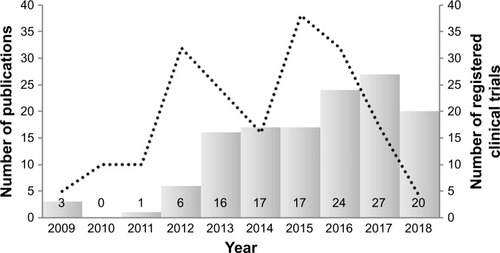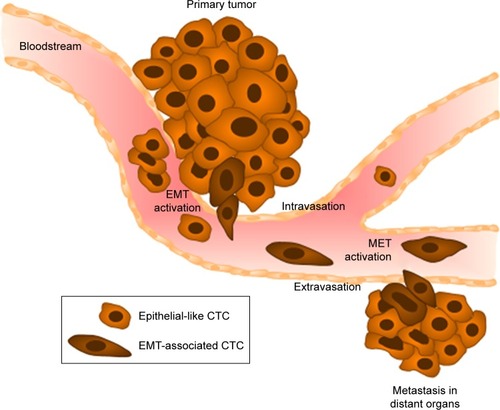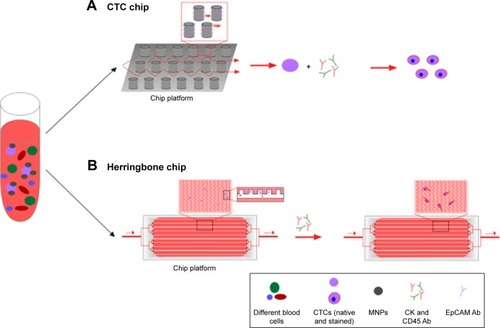Figures & data
Figure 1 Timeline of PubMed entries.
Notes: Search criteria included “nanotechnology” AND “CTCs”, “nano” AND “CTCs”, and “nano” AND “circulating tumor cells” to determine number of publications (columns). Timeline of World Health Organization International Clinical Trials Registry Platform entries to display the number of registered clinical trials using search criteria “circulating tumor cells” AND “nano”.

Figure 2 Workflow of patient-derived CTCs for CTC analysis, drug-resistance detection, and personalized drug-delivery systems.
Notes: Patients’ blood samples are screened and potential CTCs captured and isolated. Potential CTCs can be enumerated, determined, and stained or cultivated for further analysis. CTC culture can be used for drug-resistance detection and personalized drug development, thereby increasing patient-survival rates.
Abbreviation: CTCs, circulating tumor cells.

Figure 3 Characteristic stages of tumor-cell dissemination during metastasis.
Notes: Cells from primary tumors undergo epithelial–mesenchymal transition (EMT), leading to the loss of cell–cell adhesion and promoting local invasion into the blood vessels (intravasation). The CTCs produced are able to escape from blood vessels into distant organs of future metastasis (extravasation) after the reverse process (MET), induced by interaction with the local microenvironment.
Abbreviations: CTCs, circulating tumor cells; MET, mesenchymal-to-epithelial transition.

Table 1 Summary of key biomarkers used for CTC detection
Figure 4 Illustration of methods for CTC isolation by magnetic separation using magnetic nanoparticles (NPs).
Notes: (A) The CellSearch system enriches CTCs using iron NPs linked with anti-EpCAM antibodies (Abs). Labeled cells are magnetically separated, and can be evaluated by immunofluorescence staining. (B) AdnaTest allows the immunomagnetic enrichment of CTCs via epithelial and tumor-specific antigens. After separation of potential CTCs from PBMCs, labeled cells are lysed, in order to analyze CTC gene expression via multiplex PCR. (C) Process of MACS using superparamagnetic Fe NPs within a magnetized steel-wool column.
Abbreviations: CTCs, circulating tumor cells; PBMCs, peripheral blood mononuclear cells; MACS, magnetically activated cell sorting; RT, real time.

Figure 5 Microfluidic chip design of CTC chip (A) and herringbone chip (B).
Notes: Whole-blood sample is pushed through the surface of the chip, which is coated with a CTC-specific antibody, such as EpCAM. Chips differ in their architecture, containing either Ab-coated microposts (A) or herringbone-etched microchannels (B). Captured cells are stained for CK, CD45, and DAPI. Identified CTCs can be enumerated.
Abbreviations: CTC, circulating tumor cell; Ab, antibody; MNPs, magnetic nanoparticles.

Figure 6 Synergetic detection and destruction of CTCs by a “sense-and-treat” DNA nanosystem.
Notes: Reproduced with permission from Chen N, Qin S, Yang X, Wang Q, Huang J, Wang K. “Sense-and-treat” DNA nanodevice for synergetic destruction of circulating tumor cells. ACS Appl Mater Interfaces. 2016;8(40):26552–26558. Copyright © 2016 American Chemical Society.Citation142
Abbreviations: CTCs, circulating tumor cells; Dox, doxorubicin.

Table 2 Overview of NP-based CTC detection methods
